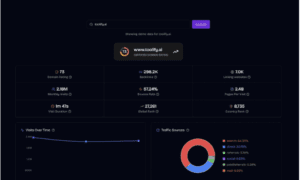When a bearish harami shows up on the chart, it doesn’t scream for attention—but it’s definitely whispering something important. This classic two-candle formation suggests that momentum may be fading, especially after a strong upward move. For traders who pay attention to candlestick patterns, the bearish harami often signals a possible pause—or even a reversal—in the trend.
The beauty of the bearish harami lies in its simplicity. With just two candlesticks, it creates a visual snapshot of uncertainty. As algorithms and real-time analytics become more advanced, this once manually spotted pattern can now be detected almost instantly, giving both retail and institutional traders a head start.
Understanding the Bearish Harami Pattern
The bearish harami consists of two candles:
- A large bullish (green) candle.
- A smaller bearish (red) candle that fits entirely within the range of the first.
This setup tells a subtle story. After strong buying, the following session fails to carry the momentum. Instead, it opens lower and closes lower—staying well within the boundaries of the prior bullish candle. It’s like the market takes a breath, unsure whether to continue higher or turn back.
While it doesn’t confirm a reversal on its own, it signals a moment of hesitation that traders can’t afford to ignore.
Why Context Matters with This Pattern
The bearish harami doesn’t exist in a vacuum. For it to truly mean something, the surrounding market conditions need to be taken into account. Here are some examples of what might strengthen the signal:
- The pattern appears near a known resistance level.
- Volume decreases on the second candle.
- Indicators like RSI are already showing overbought levels.
- Price has moved sharply higher in recent sessions.
When these conditions come together, the bearish harami gains weight. It becomes less of a random pause and more of a red flag.
How Algorithms Catch It Instantly
In the past, identifying a bearish harami meant flipping through charts manually, candle by candle. But now, technology handles this process in milliseconds.
Modern platforms use real-time pattern recognition to alert users when a bearish harami forms. These tools analyze not just the candle shapes, but also the broader trend, volume data, and even news sentiment. The result? A faster, more data-driven view of what the pattern could mean.
Machine learning models go a step further. They review thousands of past instances to predict how likely the pattern is to lead to a reversal under current conditions. This doesn’t guarantee an outcome, but it certainly gives traders an edge.
How Reliable Is It?
The bearish harami works best under certain conditions. It tends to perform better on longer timeframes, such as daily or weekly charts, than on short-term ones like the 5-minute or 15-minute chart.
That’s because longer timeframes filter out market noise and highlight genuine shifts in sentiment. When this pattern appears on a daily chart after a strong rally, it deserves more attention than if it appears mid-session during sideways price action.
Additionally, the pattern’s reliability increases when it aligns with broader technical indicators or macro developments. It’s all about combining signals rather than relying on one in isolation.
Real-World Application of the Bearish Harami
Let’s say a stock has been on a five-day winning streak. Each day brings higher closes and stronger volume. Then, a large bullish candle appears—followed the next day by a much smaller bearish candle that opens and closes within the range of the first.
What should you do? Some traders might tighten their stop losses. Others might wait to see if the next candle breaks lower before taking action. Either way, that harami pattern is a signal to prepare for a possible change.
This is where technology helps. Platforms that offer real-time scanning and historical pattern analysis allow you to react quickly without emotional bias. Whether you’re a short-term trader or a long-term investor, these tools add value.
Calculating Risk Around the Pattern
Although the bearish harami isn’t about hard numbers like moving averages or Fibonacci levels, it still helps to think in terms of risk and reward.
If you’re looking to trade after spotting a bearish harami:
- Your stop-loss might go slightly above the high of the first candle.
- Your first target could be a recent support level or moving average.
- The key is keeping risk small and letting the chart guide your next steps.
Risk management is where many traders go wrong. A single candlestick won’t save you from poor planning—but it can help spark a well-timed adjustment to your strategy.
Conclusion
The bearish harami might not be the flashiest candlestick pattern out there, but it’s certainly one of the most telling. Its subtle structure hints at hesitation—a small break in strong momentum that could be the beginning of a shift.
Technology has made it easier than ever to identify this pattern in real time. Whether you’re using basic charting tools or AI-driven platforms, recognizing the bearish harami gives you a helpful heads-up that something may be changing.
Platforms like Alchemy Markets are making these insights more accessible, offering traders of all levels a chance to react with clarity, not emotion. As with any tool in technical analysis, success lies in how you interpret the data—not just spotting the pattern, but placing it in the right context.
And the more experience you gain—especially through structured approaches like an Elliott Wave course—the more valuable these small signals become in your decision-making toolkit.
FAQs About the Bearish Harami
Is the Bearish Harami a Reversal Pattern?
Technically, yes—but it’s better described as a potential reversal or slowdown signal. On its own, it doesn’t guarantee a move down. Instead, it should alert you to watch price action closely in the next few candles.
Can Beginners Use the Bearish Harami?
Absolutely. The pattern is simple to spot and understand. Even if you’re just starting out, it helps build your confidence in reading price charts. Just remember to consider the bigger picture before acting on it.
How Does It Compare to Other Patterns?
It’s subtler than a bearish engulfing pattern but can be just as effective in the right context. The harami often appears as the market starts to slow down, while an engulfing pattern typically signals more decisive rejection of a price level.
How Does It Fit Into Wave Theory?
For traders studying wave structures, especially those diving into an Elliott Wave course, the bearish harami can appear near the top of corrective waves or as a signal that a fifth wave may be losing steam. It’s another tool that adds clarity to wave counts and helps confirm possible turning points.
Should I Act Immediately After Spotting One?
Not always. It’s usually wise to wait for confirmation—like a lower close in the next session or other indicators pointing to weakness. Patience tends to reward those who don’t rush into trades based on a single candlestick pattern.



































